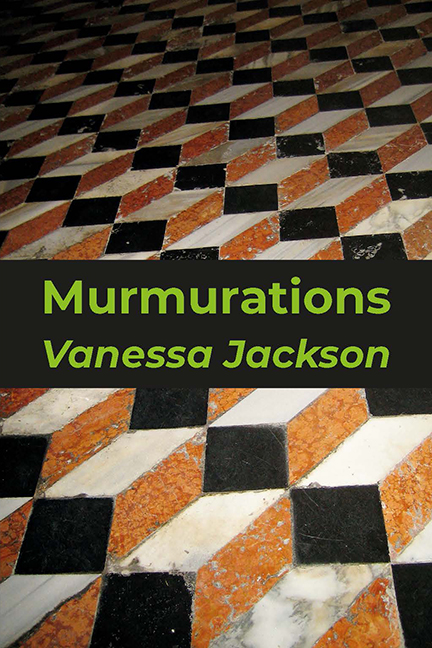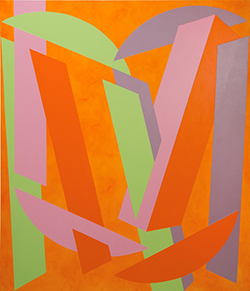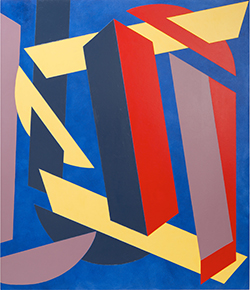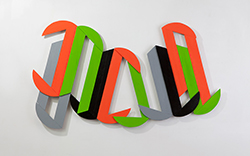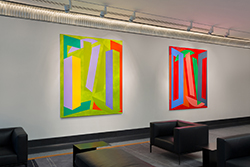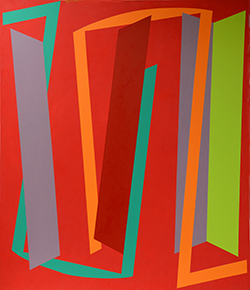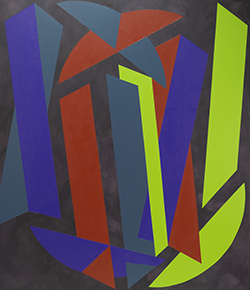Jackson
12.12.2022
Stolen and Contaminated - The Form, The Function, and the Ornament
A lecture in memory of Sandra Blow.
I would like to begin by thanking St Martins, Mick Finch and Mark Dunhill, for inviting me to give the first lecture in memory of Sandra Blow. St Martin's was inspirational for me, as I imagine it was for her.
The 'Declaration of Feminism' came to London in November 1971, a couple of months after I had started on Foundation at St Martins. It had to be London for Art School, and although I looked at other colleges, this one was 'it' the minute I walked in the door: the Charing Cross Road plus Soho and the National Gallery just down the road. Bookshops on every corner, and pubs by which we learnt to identify the terrain; the Cambridge upstairs for Foundation and Painting, the Angel at St Giles for Graphics, the Marquis of Granby, Complementary Studies and the Pillars of Hercules for Sculpture. Patisserie Valerie's was a hang out for Fashion and everyone else joined them. The Library was our social centre during the day.
Coming to painting in the early 1970's I arrived already steeped in the love of Van Gogh, Matisse and Rothko to enter an extraordinary and discombobulating climate of late minimalism, conceptualism, theoretical Marxism and early second wave Feminism. Painting as a practice was in flux, considered by many as 'bourgeois', and following history, not 'herstory'. Modernist canons were imploding so it was a challenging time. This was a period of change that demanded a sense of responsibility and a desire to both inform and question ones relationship to making. It was a volatile time politically; many a weekend found us on demonstrations, from Anti Vietnam to Pro Abortion, Equal Pay, CND, Troops Out,and Gay Liberation LFGAA (Gay Liberation Front and Gay Activists Alliance) and then later against Thatcher, Thatcher the Milk Snatcher when she was Minister for Education and later Rock against Racism. Greenham Common came later still. My last year at St Martins, 1975, Barbara Castle finally managed to push through Equal Pay.
St Martin's was infamous for its parties, Kilburn and the High Roads were the regular band, later to be Ian Dury and the Blockheads. I learnt to rock n roll in the union bar and school hall and even went on stage as Aladdin, principle by, in the then annual Freddie Gore Christmas Panto, with Gillian Ayres as an exotic peacock and Albert Herbert as my completely naked gold painted genii. Head of Painting and two senior tutors.
So starting out as a painter life was busy and exciting, and a good time to learn. A period of action and reaction with constant stimulus. There was a need to both question ones practice with theory and to justify its very existence. The demands of feminist and conceptual ideas did make for vital engagement for all of us, creating a discursive culture that opened up a far more pluralistic future. I learnt very early that the solitary discipline of painting was in itself a form of thinking through the sometime conflicting interests of political consciousness and personal curiosity. The first discipline was Art History, and this was still determined by the traditional study of 'Giotto to Cezanne' but fortunately at St Martins under threat from a lively Complementary Studies programme. I studied poetry with Annie Lauterbach who introduced me to a job working for Ambit Literary magazine, I job I continued for seven years, Ray Durgnat for Film Studies, John McAdam for Architecture and my first introduction to Phenomenology through a memorable lecture on Alberti and Palladio, playing Monteverdi and talking about Merleau-Ponty. And, perhaps most influentially John Tagg; he of 'The Burden of Representation' fame. He brought us John Berger, Lucy Lippard, TJ Clarke along with Hegel, Walter Benjamin, and Ortega Y Gasset and Gramsci, and of course Karl Marx.
Very early on I was drawn towards the use of geometry as a form of democracy, a visual system that already existed carrying its own diverse and multi layered histories. I had no desire to 'invent' but I needed a place and a space in which to think and make sense. The disinterested situation and promise of autonomy that Rosalind Krauss refers to in her well known essay on the use of the grid. Using Geometry was a way of objectifying the practice, looking for a structure that already existed with no overt desire for self expression. I became curious about systems and structures of geometry through Euclid and Pythagarous, Fibonacci and Alberti, reading Platos Republic and Thomas More's Utopia and even the Communist Manifesto. Finding parallel relations that made sense intellectually, visually and socially.
There is an obvious connection to Utopias here, and I had an affinity with the Russian Constructivists through Malevitch and the female artists involved in this revolutionary movement, Popova, Exter, Goncharova, Rozanova et al. This was to take me on a journey that would spin back to Byzantium and then forward to the Baroque, Malevich to Mondrian, Popova to Poussin. Reading from Vasari and Goethe on trips to Italy searching out Giotto and Pierro della Francesca with phenomenology back in the studio. I was moving between a contemporary connection with the American artists Frank Stella , Al Held, Agnes Martin and a bit later Elizabeth Murray whilst looking back towards Stuart Davis and Leger. The New York School through the lens of the School of Paris.A complex set of histories that somehow connected.
There was a dislocation between so called practice and theory and to a great extent that remains, as not all the words I read are theory, and art history has always been my guide. My earliest stab at finding connections between painting and theoretical “research” was my undergraduate dissertation that had the audacity to use a Wittgenstein quotation as its title:
'What finds its reflection in language, language cannot represent. What expresses itself in language, we cannot express by means of language. What can be shown, cannot be said. '
Back then, in 1974, my naivety was to use this quotation for the purely personal context of somehow justifying my practice as an abstract painter. Much more recently I have had time to question what is meant by representation, and to find in the Tractatus a depth of inquiry that opens the possibility for a reflective capacity where the simultaneity of reflection and experience may be elucidated in the making of a form of abstract representation. Mondrian used the expression abstract real. Wittgenstein refers to the external real.
The to and fro of finding and seeing has a particular theory of its own making. Dwelling in Art History is to look through time and across countries, cultures and eventually continents. This is an intricate geometry of cross referencing politics and religion, empires and trade, and the associations of time and memory.
Geometry gave me the sense that one could construct without referencing the appearance of the world; offering a structure in which to manifest experience. Mondrian's term 'Abstract Reality' , from his Trialogue Essay, suggests thinking the form where there is no third party, but a discourse that could be made directly with the work; the drawing; the painting. Representing experience through the slow manipulation of geometry is both a recognition of the formal histories of painting whilst incorporating the familiarity of its language. I have a love of systems, including scoring for cricket and playing sudoku, and colour theories continue to fascinate me. In 1977 I wrote my RCA dissertation on Sonia Delaunay and was fortunately introduced to her by Peter de Francia, interviewing her in Paris about her work and life. She had a particular involvement with Chevreul's colour theories, Suerat's great influence, and this became an important part of my text. From her I heard wonderfully engaging stories from her experience of Robert Delaunay and the Arps, Sophie and Hans, Leger and Brancusi as well as the poets Appollinaire and Cendrars.
Geometry, the form and the function, has multiple relations to the world and from the vast space that is architecture to the minutae of DNA, the constructed and the organic. My earlier work played more with the organic and biomorphic, related perhaps quite directly with ones own sexual body. Recent work has far greater influences from the architectural, as I become more cerebral in maturity! To paint is to be engaged in a constant process of reciprocal interaction between the present physical and intellectual activity and an anticipation of the future. The present is made up of the past experience and that unpredictable state of memory, whilst the actual practice and its summation is in the present. Now. In reference to architects drawing Descartes refers to 'taking an intuition of the whole'
where there can be no method without discourse. Descarte promoted a philosophy suggesting that mental representation may encompass ideas as image; ideas to represent things that are not present, and this extends to the sensory perceptions alongside abstract thought. (Claudia Brodsky Lacour, TheThings a Thinking Thing Thinks, from Lines of Thought.
Drawing towards painting, actually and metaphorically, the process is a compulsive ordering and sorting of forms in a notebook. The ground is set up as an open ethereal, thinly painted 'unobtainable' space. A space of illumination, sometimes synthetic at times almost 'natural' in hue. A charge of colour, as light, upon which the concrete 'real' is constructed from geometry to reinforce a sense of actual existence. To quote from Merleau - Ponty;
"It is no more possible to make a restrictive inventory of the visible than it is to catalogue the possible usages of a language or even its vocabulary and devices. The eye is an instrument that moves itself, a means which invents its own ends; it is that which has been moved by some impact of the world, which it then restores to the visible through the offices of an agile hand."
Thinking the form; the continuity and the disruptions.
Bergson in Matter and Memory,
'What is real is the continual change of form: form is only the snapshot view of transition.'
The multiple functions of geometry are a part of our everyday life, the system by which we move through space and time, from the uses of a domestic utensil to the astrologer's map. For me it is also a psychological space for recalling or charting memory experience. Gaston Bachelard, in the Poetics of Space, refers to the house as a 'psychological diagram' whilst Mondrian in the Trialogue, (with spiritual references to theosophy), refers to the determination for a plastic vision as a preparation for future architecture'
I look to construct paintings that offer a space for reflection, geometry in two and three dimensional familiarity of initial recognition. They are made slowly. Slow to make and slow to look at. Slow to unravel or ‘unconceal’.
Painting in the studio with concentrated time allows for speculation. Time spent in the slow accumulation of matter. Layers become suspended in the illusion of geometry. It is a gradual process of holding things together, of making sense or unconcealing, the event of unconcealing or disclosure; grounded in experience to deal with experience, as Heidegger would put it. It is not the unwrapping of history or the process of revealing; no traces, no narrative. It is a demand for time to be held now, actual and in the present. Painting as a container to hold sensory perception. Time for assimilation, to take hold, to think to listen. The activity is repetitious, literally holding time in the geometric frame.
'Dwelling' in the frame of painting. In Heideggers 'Building ,Dwelling, Thinking' there's an analogy with a bridge. A built structure but not exactly a dwelling. The point of the bridge is to go across and one is in perpetual motion. The bridge is 'earthed' at both ends whilst above the bridge the sky is in perpetual motion and under the bridge is flowing water, or the M25. I think painting practice is quite like this, its earthed at both ends, its earthed in the doing of it but the space in between, the to and fro, the coming and going, and the sky above is thinking and moving.
The Origin of the Work of Art
'The actuality of the work has been defined by that which is at work in the work, by the happening of truth. This happening we think of as the instauration of strife between the world and earth. Repose occurs in the concentrated agitation of this striving. The Self composure of the work is grounded here.'
In the work, the happening of truth is at work.
Heidegger’s particular use of the word ‘Dasein” literally ‘being here’ is central to ones human idea of understanding existence and the process of making, understanding in seeing. The Origin of the Work of Art continues to expand my understanding, and at each new reading new ideas emerge. As literature it is complex but extra ordinary. Entering his writing is like entering the ‘real’ world.
‘Sometimes’, Helene Cixous writes in Coming to Writing,’I think I began writing in order to make room for the wandering question that haunts my soul and hacks and saws at my body; to give it a place and time; to turn its sharp edge away from my flesh; to give, seek, touch, call, bring into the world a new being who won’t restrain me, who won’t drive me away, won’t perish from my narrowness.’
I look for inclusion, of layered relationships, animated by light and opticality that is at times kinetic. To be seductive and draw the viewer in, and stimulate the consciousness of space. The vibrancy may also repel acting as a visual barrier; the dichotomy of existence. The paradox of perpetual motion and opaque stillness.
Bridget Riley in an interview with Andrew Renton,
‘I think the point is that the references themselves ARE abstract. I go for the sensation itself, not the vehicle so to speak, in which that sensation may appear. ‘
The Ornament
Having always been interested in geometry and its histories I was drawn towards Matila Ghyka, The Geometry of Art and Life, which inevitably took me on a continuous journey from the Golden Section to Gothic masons marks, and backwards and forwards through symbolic use in alchemy to Albertian systems. The very nature of painting that employs geometry has associations with both design and the abstract.
One of my favorite books is Flatland, A Romance of many Dimensions By a Square, by the 19th century mathematician Edwin A. Abbott.
The use of the ornamental comes with the territory, it is in the system of geometry and in its seduction. The botanical sources researched by Alois Riegl in the 19th century in his book Problems of Style, demonstrates an uninterrupted continuity in the use of ornament from Egypt to the Islamic Period in Europe, through to the eventual influence of the Gothic revival in Britain. His description of the Lotus Blossom and Acanthus leaf from Luxor to Istanbul to Pompeii is a staggering account of the ornamental relationship to both aesthetics and style. The shared histories and visual obsessions.
Oleg Graber in his 1989 book, The Mediation of Ornament , compares an Iranian 15th century painting to Mondrian’s Broadway Boogie - Woogie. He refers to ornament as the carrier where the carrier becomes the object:
‘There is a difference between filling a space with a design and transforming an object by covering all or parts of its surfaces with that design. In the first instance the filling design has no purpose other than to partake of whatever uses its carrier has; in the second one, it can transform the very purpose of its carrier.’
Ornament is part of the structure not an added extra.
I look to form the gestalt between the phenomena that is visually and physically experienced to that which is intellectually understood. A compulsion to make tangible sense through painting of both the matter and confusion of everyday life. Harmony and dissonance both take their part.
Geometry found through architecture enters actual space, but as a painter I continually respond to the experience of architecture whether it be Mies van de Rohe, and the Barcelona Pavilion or the ornate Baroque of Borromini, in which the oval and the cupola embrace the space. Sant Ivo, Rome etc. The Rotunda/ Pantheon in Rome and its open eye, or ocular, overseeing the 2000 year old marbled geometric floor, never ceases to amaze me.
In studying Heidegger, the theory of ‘hermeneutics’ comes into questioning beyond it’s traditional usage for the interpretation of religious texts. Both Heidegger and his student Gadamer approached hermeneutics as a method of understanding and translation of language at a more fundamental level defining the task of hermeneutics as the bridging of personal or historical historical distances between minds.
“Being that could be understood is language” Gadamer. Reasoning as dialogue. I believe this is also possible through looking and absorbing visual phenomena, and the interconnectedness of visual cultures and their histories.
A few years ago I enjoyed taking part in a group exhibition with seven painters, three from USA and four from Britain entitled ‘Warped, Painting and the Feminine’. We shared a curiosity in so called non representational painting and the catalogue contained an edited version of our trans-Atlantic discourse about the language of representation, and as ‘abstract’ artists our relationship to feminist theories. A very interesting aspect of the conversation was due to our age differences ranging from mid 50’s to early 30’s and how our entry period into practice had influenced the language we used about and indeed shaped our work. Terms like ‘the decorative, or ‘the use of pattern’ or ‘the ornamental’, all had their dissenters or supporters, whilst we delighted in the linguistic debate that surrounded our personal practices.
Maggie Ayliffe. UK
Jo Bruton. UK
Joanne Greenbaum. USA
Vanessa Jackson. UK
Valerie Jaudon. USA
Shirley Kaneda. USA
Rosa Lee. UK
ART HISTORY
A STORY
Midnight in Genoa or Travels in Art History.
In Fourteen Hundred and Ninety Two Columbus sailed the ocean blue.
Columbus offered to find John II of Portugal a sea route to the Orient by sailing westward across the Atlantic, but finally took his offer to Ferdinand and Isabella of Spain, who agreed to back him. He set sail on the 3rd of August 1492 with the Santa Maria, the Pinta and the Nina and on the 12th of October reached San Salvador Island in the Bahamas. He went on to explore what he thought to be part of mainland Asia, and an island which he imagined was Cipango ( Japan ), and named it Hispaniola. In the very same year Ferdinand and Isabella made their final assault on Granada and the last Muslim rulers in Spain, ending nearly six hundred years of Spanish Christian /Islamic history. The Jews had their rights revoked and so were expelled too. There is something more than irony in this abbreviated tale; because according to Richard Gott's fascinating book on the history of Cuba, Columbus passed the northern shores of Cuba on his first trip but in 1494 he returned and landed at Guantanamo Bay. Columbus would have been unable to explore without the financial assistance of the Jewish population or the navigational expertise of the Moors. Recently a new mosque has been built in Grenada.
A few years ago I finally visited Granada and the Al Hambra where the form, the function and the ornament are inseparable, inside and out. From the mosaics to the mocarabes ( ornamental stalactites structuring cupolas),the courtyards and the formal gardens. Incidentally, the story of the mocarabes is that according to Muslim tradition the prophet Mahoma received his inspiration for the Koran directly from the Archangel Gabriel in the famous cave at Hira where he had sought refuge while fleeing from his enemies. A spider's web miraculously sealed the entrance to the cave to confuse his pursuers. In celebration of this event stalactites became an essential ornamental element, imbued with religious connotations, throughout the world of Islam, a tradition persisting even to this day. The use of the ornamental comes with the territory; it is inside the very system of geometry and in its seduction. Painting carries its own histories with it too; it is in its eclectic nature to do so. It is a slow practice for me, but as I have traversed a little way from Mesopotamia to Rome, Byzantium to the Baroque, from Gilgamesh to Goethe I think about present day globalisation. I also wonder about the dangers of cultural tourism, but as the much lamented Edward Said wrote in an essay published in the Guardian in August 2003, he pleaded for a rational understanding that was specifically cultural.
'Rather than the manufactured clash of civilisations, we need toconcentrate on the slow working together of cultures that overlap and borrow from each other, and live together. But for that kind of wider perception we need time, patient and skeptical inquiry, supported by faith in communities of interpretation that are difficult to sustain in a world demanding instant action and reaction.'
Because geometry is the rubric that has guided my practice and its continual associations with both design and the abstract, it has also structured the complicated and often idiosyncratic relationship that I make with history and the present day.
He also quoted from Goethe, referring back to a time when philology was taken seriously, as the interpretation of texts to support the kind of understanding that Goethe advocated for his understanding of Islamic literature.
Said’s anxiety of globalization that lacks cultural understanding, is balanced by his embrace of a new collective constituency that was enhanced by the United Nations World Summit in Johannesburg 2002. It gave
the often facile term of ‘one world” a new urgency.
Meanwhile to return to the modernist perspective it is intriguing to note that the architectural plans for Baghdad by Frank Lloyd Wright have re emerged from 1957. Mina Marefat, Rockerfeller fellow in Islamic studies at the US Library of Congress, has suggested that they might be put into construction.
There is no doubt the Lloyd Wright was highly influenced by Islamic architecture, it’s great history and tradition, and that his geometric design was derived from the Mesopotamian circular earthworks and conical ziggurats and domed buildings. Marafat asks for a time of reassessment:
'now that the definition of cultural heritage has finally been expanded beyond physical objects and buildings and includes crafts, customs, social habits and collective memory, something Wright intuitively recognised half a century ago.'
Somehow one doubts that a scheme of this sort would be seen as anything other than another form of American Imperialism and perhaps the international architect Zaha Hadid, originally from Iraq, would have better credentials.
Art History like History itself, is in perpetual motion, to and fro, much like the practice of painting in the studio, with the pleasurable resonance of actual experience held somewhere between the memory and the activity.
A boundary is not that of which something stops but, as the Greeks recognised, the boundary is that from which something begins its presencing.
Heidegger, "Building, Dwelling, Thinking"
Reading for me, is as likely to be a novel or a poem. All the Existentialists plus Italo Calvino, Sebald, Virginia Woolf, Murakami, Oran Pamuk,Jeannette Winterson, or Adrienne Rich and Carol Ann Duffy; Proust in bed and Heidegger in the studio. Whatever it is, it has to be beautiful literature. As Walter Benjamin recounts in Illuminations, our lives are portrayed and recounted through our bookshelves.
Painting is the non literal, a separate accumulation of languages. and in words
‘Language is not all history, but history is all words. But to pursue the gap between the senses and language in which the body thinks doesn’t sound like an historically irrelevant project.’
Jeremy Gilbert - Rolfe, from Beyond Piety on Non representation.
In conclusion
I am concerned at this point that Heidegger also said that if you are too stupid to think you tell an anecdote. But, as a man who wanted to be understood as a philosopher said to Dr Johnson,
'cheerfulness keeps breaking through'
Vanessa Jackson 2010
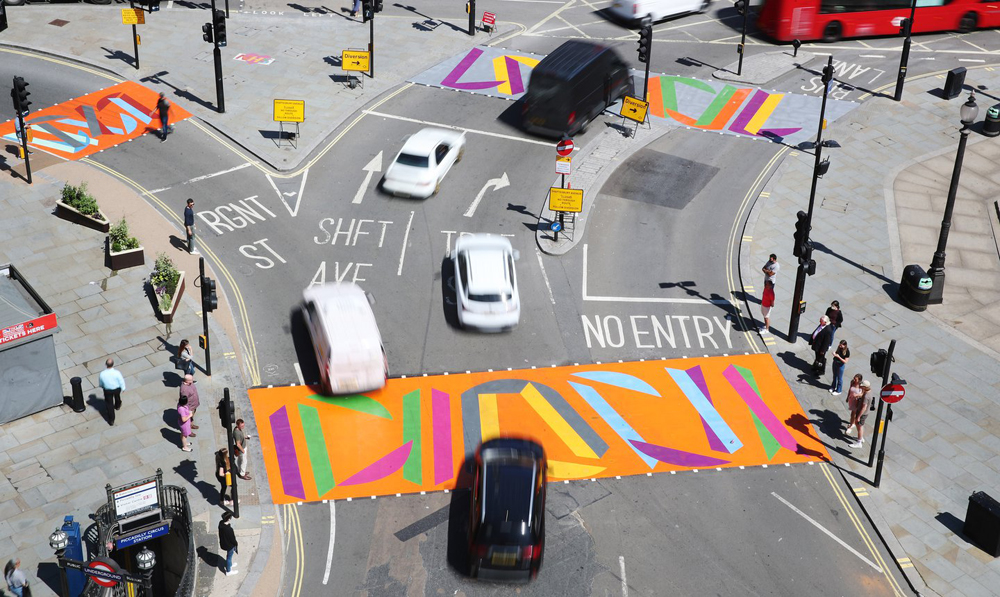
UpTownDancing
Piccadilly Circus, London, 2021
Murmurations
BY VANESSA JACKSON, 2022
To read this book is to step into the studio of a painter. These writings, rich sources of information, share thoughts, processes and practices that together demonstrate links between geometry, visual perception, history and literature. Murmurations is constitutive of an ever-expanding studio and in its midst a life—a painter's life—comes to take place.
'Murmurations is a valuable and erudite gift to the reader. Vanessa Jackson pulls us into shifting and discursive thought- drifts in which we encounter a passion for the rigour of geometry, reflections on the design of the writing of Proust, the relationship between a tripod and a pyramid, Chopin pacing the lawn as he improvises in his head, the ways in which art might make and hold time. Above all, Murmurations viscerally embodies the artist in the studio, thinking alongside the voices of history and art history in the present tense.' - Deborah Levy
Available to purchase from Copy Press or your local bookshop
